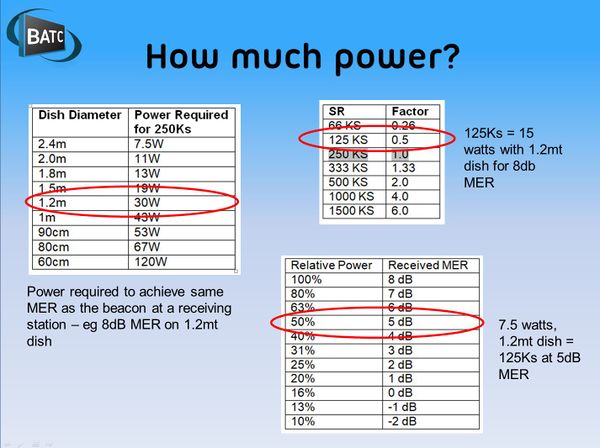Difference between revisions of "Transmitting Oscar 100 DATV signals"
| (2 intermediate revisions by 2 users not shown) | |||
| Line 4: | Line 4: | ||
==DATV transmit systems== | ==DATV transmit systems== | ||
| − | To transmit DATV on Oscar 100 you will need a system to generate DVB S or DVB-S2 ( | + | To transmit DATV on Oscar 100 you will need a system to generate DVB S or DVB-S2 (preferred) on 2400MHz. |
[[File:Tyoical 100 transmit.jpg|600px]] | [[File:Tyoical 100 transmit.jpg|600px]] | ||
| Line 14: | Line 14: | ||
The BATC Portsdown 2019 system using the LimeSDR mini is ideal for transmitting signals to Es'hail-2. | The BATC Portsdown 2019 system using the LimeSDR mini is ideal for transmitting signals to Es'hail-2. | ||
| + | |||
| + | ===Custom DATV PlutoSDR firmware === | ||
| + | |||
| + | [[Custom_DATV_Firmware_for_the_Pluto]] | ||
==Dish size and power required== | ==Dish size and power required== | ||
| Line 29: | Line 33: | ||
It is possible to home-construct power amplifiers for the 2.4 GHz Band. Jim G7NTG describes his Ampleon BLC2425M9LS250 based project here: [[:Media:G7NTG 250 Watt amplifier for EsHail.pdf]]. | It is possible to home-construct power amplifiers for the 2.4 GHz Band. Jim G7NTG describes his Ampleon BLC2425M9LS250 based project here: [[:Media:G7NTG 250 Watt amplifier for EsHail.pdf]]. | ||
| − | Setup instructions for the 75W Spectrian modules are here: [[:Media:Spectrian amp setup.pdf]]. | + | Setup instructions for the 75W Spectrian modules are here: [[:Media:Spectrian amp setup.pdf]]. M0DTS has published more information here: [http://www.m0dts.co.uk/index.php?item=77 M0DTS Blog]. |
Latest revision as of 21:01, 13 February 2020
To transmit DATV signals on Oscar 100 you need to be able to generate DVB-S2 signals on ~2400 MHz. This page outlines some possible transmit systems.
For a full guide to transmitting DATV on Oscar100 see CQ-TV 263 here: https://batc.org.uk/cq-tv/cq-tv-download/
DATV transmit systems
To transmit DATV on Oscar 100 you will need a system to generate DVB S or DVB-S2 (preferred) on 2400MHz.
Systems include:
Portsdown system
The BATC Portsdown 2019 system using the LimeSDR mini is ideal for transmitting signals to Es'hail-2.
Custom DATV PlutoSDR firmware
Custom_DATV_Firmware_for_the_Pluto
Dish size and power required
There are 3 key variables: dish size, power and symbol rate. The power received at the satellite varies with the square of the dish diameter, so for example a 1.2m dish will give 4 times the amount of power (6 dB more) than a 60 cm dish. The power density in terms of frequency will vary inversely proportional to the symbol rate. So a 250 KS signal will deliver double the power density (watts per MHz) at the satellite compared to a 500 KS signal of the same transmitted power.
Based on observed performance of the transponder, this table gives the power required and dish size to achieve the same level as the beacon at 250 KS:
To see the full article, including how the power required varies with symbol rate and lower MER, see CQ-TV 263 - available for download here https://batc.org.uk/cq-tv/cq-tv-download/
Power Amplifiers
It is possible to home-construct power amplifiers for the 2.4 GHz Band. Jim G7NTG describes his Ampleon BLC2425M9LS250 based project here: Media:G7NTG 250 Watt amplifier for EsHail.pdf.
Setup instructions for the 75W Spectrian modules are here: Media:Spectrian amp setup.pdf. M0DTS has published more information here: M0DTS Blog.

